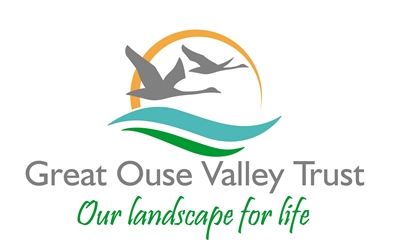It’s that time of year and Bridget Flanagan of the Great Ouse Valley Trust describes a continuing local tradition.
While the sun shines – our photograph depicts an idyllic July scene along the Great Ouse: visiting cruisers and narrow boats moor alongside Noble’s Field, sculling boats from St Ives Rowing Club enjoy the early evening, and runners and picnic groups can be seen along the river bank. And among all this leisure, there is the urgent work of making hay. The flower-rich meadow grass is ready to be cut when the leaves are tall and the seed heads not over ripe. Once cut it needs lots of sun to ‘cure’ it, then after a day or two it is turned to ensure it dries evenly. More drying, then it is raked into rows to be baled, loaded on to wagons and taken to dry storage. The hay from Hemingford Meadow is sold at the St Ives Straw and Hay Auction in January. Prior to the auction, buyers from Newmarket, Wales, London and across the country visit the barns to assess the quality of the hay. Most are buying hay for horses; they are regular customers who value this meadow hay with its sweet smell and silky texture.
On Portholme Meadow, in the parish of Brampton, the hay is cut by several farmers. The meadow is now owned by the London Anglers’ Association and in a centuries-old tradition it is divided, according to a map of 1772, into many parcels of land. These ‘hay lots’, which include the right for aftermath grazing by sheep and cattle, are auctioned on the Wednesday nearest to June 15th at The George Hotel, Huntingdon (but by internet, in the Covid years of 2020 and 2021). When the hay is ready to be cut, a local farmer marks out the meadow into individual lots by cutting ‘roadways’ - one width along each boundary - and receives that hay as payment for the work.
Modern hay making is entirely mechanised and uses ever bigger, and faster machines. A far cry from the days when teams of men and women laboriously scythed, turned, raked and tossed the hay. But successful hay making is always reliant on the weather – and some years may be unlucky with rain which can spoil or even ruin the crop. Hence these July days have been busy. They are the culmination of the traditional cycle of management of the meadows: grazing by animals in the autumn and early winter, storing of winter flood waters, then ablaze with flowers in the wonderful weeks of May. So - make hay while the sun shines.

Making hay on Hemingford Meadow
Photograph by Alan Bennett at Media Imaging Solutions. We acknowledge permission for photography from L. Radford Esq and for assistance with research from Dr Pat Doody
The Great Ouse Valley Trust promotes for public benefit the conservation, restoration and enjoyment of the landscape, wildlife and heritage of the Great Ouse Valley and environs in the county of Cambridgeshire. For more information about the Trust please visit www.greatousevalleytrust.org.uk


